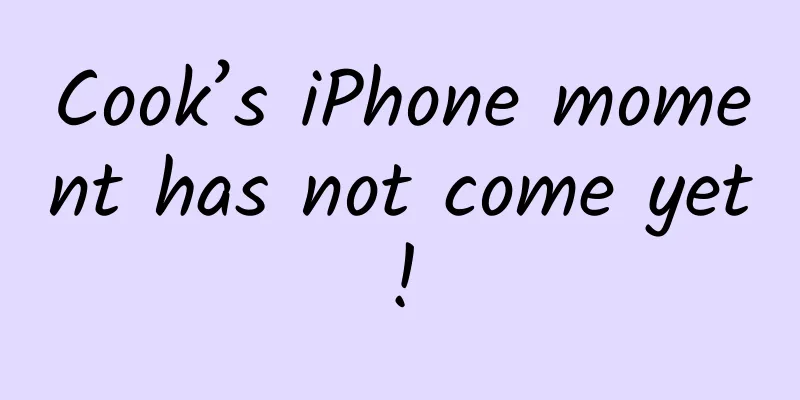Cook’s iPhone moment has not come yet!

Click to participate in the 51CTO website content surveyWritten by Qianshan Recently, there has been a lot of discussion about Vision Pro. In the field of mixed reality (MR), Apple finally has a product that can be put into use. As an MR headset launched by Apple, the pre-announcement of Vision Pro has already pushed it to the peak of attention. After the official release, although some industry insiders believe that this is a watershed in the industry, this hardware product that has been "late" for a long time does not seem to have achieved the effect of "thunder from the blue sky". This is the second major product line expansion after Apple Watch since Apple CEO Tim Cook took power in 2011. Cook declared at the meeting that if Mac brought personal computing and iPhone brought mobile computing, then Vision Pro marks the beginning of the era of spatial computing. But for the general public, the debut of Apple’s first commercial headset after a seven-year delay is certainly worth celebrating, but compared to expectations, the surprise it brings is not that great. So how did Vision Pro create the current situation where there are both highlights and flaws? Can MR become Apple's "rejuvenation pill" to solve its sluggish growth problem? How long will it take for XR to have its own iPhone moment? See the analysis below. Source: Internet 1. The most impressive thing is the price of $3,499The so-called MR integrates the two functions of virtual reality (VR) and augmented reality (AR). Apple's headset looks like ski goggles, equipped with two chips, a 23-megapixel display, 12 cameras, one sensor, and 12 microphones, allowing users to "travel" between the physical and digital worlds. As the most important hardware launched by Apple in the past decade, Vision Pro starts at US$3,499 (currently approximately RMB 25,000), far exceeding similar products, and is scheduled to be shipped early next year. The Vision Pro's bill of materials (BOM) has been leaked online, showing that the Vision Pro's material cost is about $1,509. Among them, the two internal screens account for $700, which is the most expensive component and is supplied by Sony. In addition to the hardware costs that are visible to the naked eye, Apple's pricing may also be due to its confidence in the user experience. Vision Pro is equipped with VisonOS, which Apple calls the world's first space operating system. Technology journalist Chance Miller, who experienced Vision Pro firsthand, described his feelings. In terms of interaction, users can completely rely on their eyes, hands and voice to operate. For example, with hand gestures, "you can select an object by simply tapping your finger. You can zoom in on an object by tapping and pinching your fingers, and scroll by shaking your wrist, just like on an iPhone." In terms of applications, the main ones include watching 3D movies, taking space photos and videos, and having FaceTime conversations. In terms of viewing experience, "I can't see a single pixel on the 4K monitor, and even the edges of the content on both sides of me are clear." More critically, the mix of virtual reality (VR) and augmented reality (AR) strikes a good balance between immersion and keeping you engaged with the people around you. "Throughout my time with the Vision Pro, Apple repeatedly emphasized the various ways the headset lets you stay connected to the world around you. For example, I could look left and right at the other two people in the demo room." In addition, regarding the question of whether wearing the headset would cause discomfort, Miller said that wearing it for a long time would definitely make people bored, but he did not feel dizzy during the 30 minutes he wore the Vision Pro. Apple Vision Pro user interface view Overall, this device can be said to be a ceiling-level achievement in the MR field. Both its structure and performance are impressive, but netizens at home and abroad have also pointed out many of its shortcomings. 2. The technology is cool, but a bit "flashy"The complaints about Vision Pro mainly focus on the following three aspects: battery life, price and application. First, unless the device is plugged into a power source, it must use a wired battery. And this independent wired battery has a battery life of only 2 hours. The reason why Apple chose an external battery pack is undoubtedly to avoid integrating the battery pack into the headset and increasing the weight of the headset. Regardless of whether it is convenient to carry a battery box with you, the key is that the battery life is really not good. Screenshot Comments Second, the $3,499 price tag also makes people wonder who Apple wants to pay for this device. Just two days ago, Meta launched the next-generation consumer headset, Quest 3, with a starting price of $499 for 128G. The price of Vision Pro is about seven times that of Quest 3. And with such a high price, Apple may not expect it to sell well. According to Bloomberg, Apple's annual sales forecast for this product has been lowered from the initial 3 million units to 150,000 units, a drop of more than 95% from the initial target. Third, the vision of the app described by Apple cannot cover up the "flashy" part. In other words, this product does look cool, but it doesn't seem to be of much use. Screenshot Comments As Apple demonstrated at the launch event, the headset can immerse people in it and achieve a certain "immersive" effect. However, wearing a headset to shuttle between reality and virtuality can sometimes seem disconnected and put the cart before the horse. Many netizens described their imaginations about this. “Would anyone really want to sit on the couch with a headset on (plugged into an outlet) and scroll through vacation photos instead of sitting on the couch with family/friends and watching a movie?” "Recording a video of a kid's birthday is one of the most ridiculous things I can think of. I might occasionally record my kid in this way, but I certainly wouldn't rush out and put on 'ski goggles' while he blows out the candles." In addition to entertainment, MR devices, as a tool to improve productivity, also have various drawbacks. As the engineer in the picture mentioned, Vision Pro seems to free you from the constraints of the monitor, but it also increases the burden on your eyes and neck. In the final analysis, these applications cannot be called true "killer applications" and cannot bring about substantial changes. Screenshot Comments Industry insiders also have their own opinions on Vision Pro. Rokid Product Technology Director Zhao Weiqi believes: "Vision Pro is definitely the world's top product. It is not easy to integrate more than a dozen cameras and sensors. Unfortunately, there are no refreshing scenarios in terms of application. Many of them are old clichés in the industry for many years. Moreover, for the scenarios currently displayed, its price and form may not be suitable. However, from the perspective of the industry as a whole, the release of Vision Pro is beneficial, because as the industry leader, Apple's release has increased market and public awareness. People who did not understand AR and MR before may now learn about them." 3. The chess players: Google collapsed, Microsoft moved forward quietly, and Meta made a desperate betIn addition to Apple, there are many major technology companies that are interested in competing in the AR/VR field. Google is one of the earliest companies to enter the AR field. In 2012, it launched AR glasses called "Google Project Glass", which claimed to be able to take photos, make video calls, surf the Internet, etc. Unfortunately, this product was eventually aborted due to controversy. However, Google did not give up. At last year's I/O conference, it demonstrated another AR glasses, which looked like common frame glasses. The main function was real-time translation. After wearing it, the user can see the translation of the interlocutor in real time, similar to the effect of subtitles. Microsoft, which is now in the limelight, also entered the market early and launched HoloLens in 2015. At that time, the public regarded it as "black technology". However, because it has been oriented to B-end users for a long time, the development of HoloLens has been quite low-key. However, in January this year, Microsoft disbanded all its XR business departments involved in the metaverse, including HoloLens, AltSpaceVR, MRTK, MWR, etc. In April, Microsoft released a free Windows 11 update for HoloLens 2, but so far there is still no definite news about whether HoloLens 3 will be released. Meta, which entered the market not too early but is very willing to spend money, is a true "latecomer who has surpassed the competition". Reality Labs, entrusted by Meta with the strategic task of the Metaverse, is still struggling forward with Zuckerberg's ambition despite the losses and layoffs. The announcement of the launch of Quest 3 before Apple's press conference is a strong proof. "The MR ecosystem is relatively new, but I think it will grow a lot in the next few years." Zuckerberg said that the Quest 3 headset will focus more on the mixed reality system, and it is expected that this system technology will become the benchmark for all future AR/VR hardware. Apple's entry is undoubtedly a huge threat to Meta. Facing the release of Vision Pro, Zuckerberg publicly criticized its poor social attributes and bluntly stated that Apple's "vision and values" are different from Meta's. "For the metaverse and existence, our vision is fundamentally about society and social interaction, about human interaction, and we want to make people feel more intimate in new and magical ways. In contrast, when you look at Apple's demonstrations, almost all of them are about one person sitting alone on the sofa." However, no matter how much open and covert competition there is between the two, the development of the AR/VR market is not optimistic on a global scale. IDC once predicted that the sales of headsets would increase from less than 10 million units in 2016 to more than 90 million units in five years. However, the actual situation is that by 2022, the sales of AR/VR headsets have fallen instead of rising, falling below 10 million units. In the first quarter of 2023, the decline in the shipment of headset products has further expanded to 54.4%. Back in 2021, the AR/VR market did have a "thriving" period. However, many practitioners believe that this was a "prosperity" created by Meta spending a lot of money to subsidize its flagship models to increase sales. Obviously, after the subsidies were cancelled in 2022, subsequent sales quickly weakened. Consumers who were eager to try new things were not "tamed" and formed the habit of using AR/VR devices. Meta's financial report shows that Reality Labs' loss in 2022 was 6.35 times its revenue. Meta also said that the loss was mainly due to the decline in sales of the VR headset Quest 2. The main problem for the sluggish sales is that the market demand is still unclear. Whether it is AR or VR, its application scenarios are still relatively limited. Office, playing games, and watching videos are still the main purposes of users, but these are obviously not rigid demands. This is also the reason why the outside world is not optimistic about the sales of Vision Pro. When Apple released its first generation iPhone, the global sales of smartphones had exceeded 100 million units. But today's AR/VR market does not have such conditions. 4. Cook's persistence: AR will be "a vital part of Apple's future"Judging from many previous experiences, the AR/VR track is not easy to get into. But Cook obviously doesn't believe this. Since 2016, he has repeatedly mentioned his interest and expectations in AR on different occasions. July 2016: Cook says on an earnings call: "AR is really great." He says AR will be good for both customers and business opportunities in the long run. October 2018: Cook said in an interview that AR will become an indispensable technology and emphasized that "the future is now." April 2021: Cook recognizes AR as "a critical part of Apple's future." He envisions AR being used in healthcare, education, retail, and gaming. "I've seen AR take off in these areas with the use of mobile phones. I think the future prospects will be even greater." Cook's advocacy of AR is not without reason. If we look back in time, we can find that the development of things has a certain pattern. As the first company to break through 3 trillion USD in market value, Apple has been the world's most valuable company for most of the time since 2010. In fiscal 2015, Apple's total revenue was 233.7 billion USD, which Cook once called the most successful year. However, it is a natural law that things will turn around and things will decline after reaching their peak. Changes in the internal and external environment have made it difficult for Apple to remain stable. In fiscal year 2020, Apple's net profit was $57.4 billion, and its profit growth almost stopped compared with $53.4 billion in fiscal year 2015. The culprit was the declining mobile phone market. During this period, the sales of iPhone, Apple's largest source of income, were not satisfactory. First, the product itself lacks highlights. On the one hand, the benefits brought by Apple's erosion of market share are gradually weakening. On the other hand, Apple's development in the areas of foldable screens and 5G mobile phones is not as expected. Secondly, affected by factors such as the extension of consumers' replacement cycle and chip shortages, global mobile phone shipments are on a downward trend, and the incremental market has become a stock market. Apple, which is in the midst of this, is naturally affected. At present, it is hard not to see Cook's high-profile remarks about AR in previous years as a hint of turning crisis into opportunity. Since the iPhone, the company has not produced amazing products for a long time. Apple is in urgent need of finding the next epoch-making product to continue its grand narrative for the future, and Cook’s choice is MR. 5. Looking to the future: Can MR become Apple’s “rejuvenation pill”?In the AI arms race triggered by ChatGPT this year, Apple has been very "silent" compared to Microsoft, Google and other big companies who are afraid of falling behind. Cook advocates "caution" and "deliberate consideration" when deploying AI. In fact, this also reflects the characteristics that distinguish Apple from other major companies. Apple is not without AI. The iPhone's AI photography, the Apple Watch's SOS function, the virtual assistant Siri, etc. are all driven by AI to some extent. But in the eyes of the public, the impression of Apple and AI is very thin. Cook even specifically responded to why the outside world is not optimistic about Apple's AI, "Apple's AI is not optimistic because we don't like to talk about functions that have not been realized." From the style of the press conference, we can also see that compared with companies like Microsoft and Google that like to open up their research results, Apple is more conservative and pays more attention to practical functions led by consumer needs. It rarely releases a single technology or research project to the outside world, nor does it imagine too much about a futuristic and advanced concept. It often displays finished products that are deeply tied to business and have been put into practice. Over the past decade or so, the return on investment that Apple has provided to investors has been far higher than the market average, which to some extent confirms the stability of its strategy. Therefore, before Apple launched this MR device, the market still maintained extremely high expectations. Because in the eyes of many people, the official launch of this "long-awaited" product will be a shot in the arm for the AR/VR market. CCS Insight analyst Leo Gebbie once commented: "If there is only one company that has the ability to change the AR/VR market overnight, it can only be Apple. With Apple's long-standing reputation in technology and a huge fan base, if Apple launches a headset, we expect it to perform very well." Just like the iPhone’s sudden appearance in the past, which brought about a disruptive change in smartphones, many practitioners also hope that Vision Pro can find a “killer” usage scenario for head-mounted display products that the public can truly rely on. But at present, it seems that it is far from enough. Zhao Weiqi pointed out: "At present, XR is more like a tool, a toy or a carrier. It is far from being available to everyone. In addition, the pricing of software and hardware is different, and the cost of use is also different. Before the ecosystem is established, we can only wait and see." We can wait and see whether Apple can open up new paths with MR in a rapidly changing market environment and continue to maintain its competitiveness. However, with the unstoppable development of AI, Apple is running out of time. Reference Links: https://www.theregister.com/2023/06/05/apple_vision_pro/ https://36kr.com/p/2290157296736006 https://www.thepaper.cn/newsDetail_forward_23328348 https://www.8btc.com/article/6801770 https://www.163.com/tech/article/HTOTQ68100097U7T.html |
>>: The latest trends in augmented reality and its impact on the entertainment industry
Recommend
What procedures are required for the Zhongshan local classified information mini program?
With the increasing popularity of mini programs, ...
Huanwang joins hands with Sofres to transform the smart TV industry with data
With the rapid popularization of smart TV termina...
Where can I find cheap and delicious mooncakes wholesale? Where can I find cheap and delicious mooncakes wholesale?
Where can I find cheap and delicious mooncakes wh...
[Case] How to promote mobile medical APP in an embarrassing situation!
1. Introduction The high cost and difficulty of s...
Advertising creativity is highly homogenized. How can we break the deadlock?
What should we do if our creative ideas become ho...
How much does it cost to produce the Kunming beauty mini program? What is the price for being an agent of Kunming Beauty Mini Program?
Kunming beauty mini program agents are generally ...
Mango TV is going further and further on the old path of CNTV
Recently, with the "breast reduction" o...
How can an enterprise account become a good public account? Teach you 5 tricks
Some time ago, there were many voices criticizing...
Electric Technology Car News: How can the BAIC BJ80, which borrows from others in appearance but lacks in interior design and relies on plagiarism, justify its reputation as a hard-core SUV?
Although the domestic SUV market is booming, most...
Mobile payment is having a hard time going global: Scanning is not popular, and credit card payment is also upgrading
The fact is that the majority of people who use A...
The turtles that appeared in groups on the river bank are not actually that many...
Not long ago, a piece of news like this became a ...
In January 2023, the sales of Wei, Xiao, and Li Auto decreased by 11.9%, 59.6%, and 23.4% year-on-year respectively.
When Tesla cuts its prices, does it also affect t...
Peanut Shell Dynamic Domain Name Software 3 Major Version: Client Supports WeChat Remote Management
On May 30, 2016, the new version of Peanut Shell ...
What are the functions of the Tea Mall Mini Program? How much does it cost to develop a Tea Price Mini Program?
The tea drinking culture has a long history in my ...
The methodology for 10x user growth is all here (10,000 words of dry goods)
How to solve the user churn problem using growth ...









